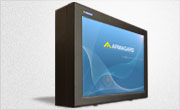Indoor and Outdoor Digital Signage – the hidden differences
Posted by: Richard Williams | Posted on: | 0 Comments
They look the same. And the screens in shopping malls and airports seem to be doing exactly the same thing as those screens outside, and yet, there are some subtle differences in the way outdoor digital signage and indoor screens function, and in the methods each system uses to obtain views.
Of course, the most obvious difference to screens function in an outdoor environment compared to those indoors is the waterproof nature of the devices. All outdoor screens require some protection from the elements as rain will soon disable a standard screen. However, outdoor screens also require temperature protection to ensure they can function in seasonal extremes, from sub-zero temperatures to temperatures exceeding forty degrees.
Coping with seasonal temperatures require the use of cooling systems and often heaters to maintain the optimum temperature for the outdoor screen. Often, these devices are hidden away inside the outdoor screen enclosure, which both houses and protects the device, but are none-the-less just as important as the water and weatherproof protection for the screen.
Another subtle difference with an outdoor screen compared to one indoors, is size. While most indoor digital signage falls within the 32” to 36” range, outdoor screens are larger. The reason for the size difference relates to how people view outdoor screens in comparison to indoor screens.
Outdoor digital signage is generally viewed from farther away than indoor screens so needs the larger size to help catch people’s attention. Outdoor screens also operate in variable brightness levels. While a display may glow and be really readable at night or in low light levels, during sunny days and in bright sunshine, readability can become problematic.
This is where another of the hidden differences between outdoor digital signage and indoor systems is required—high brightness screens. While a standard LCD or plasma will provide a readable and clear image in an indoor environment, for outdoors, the power of the sunlight on bright days can lead to an outdoor screen becoming washed out, leaving the content almost invisible.
High brightness screens normally have a nit rating (unit of luminance) three times higher than a standard screen. This extra brightness is powerful enough to cope with even the brightest of sunshine ensuring the outdoor digital signage is readable even on the brightest of days.
Post shortlink:
Popular Products
LCD Enclosure
Need armor for your LCD/LED screen(s)? Outdoors or inside the versatile LCD enclosure protects against thieves, vandals & the weather. Installation idea: NFL stadiums.
Outdoor Digital Signage
Exclusive 46” outdoor screen protection. Dubbed the ‘Totem’, due to its distinct design, it repels damage threats, but attracts audiences. Installation idea: Drive-thru restaurants.
Portrait Flat Panel Enclosure
Safeguard your eye-level advertising display screen(s), indoors or outdoors. Completely customizable, add exciting features like touch screen technology. Installation idea: Restaurant frontages.
Indoor Digital Signage
Popular purchase for retail outlets! Great for ‘point of sale’ persuasion, boost your brand with static & motion advertising from a single unit! Installation idea: Mall of America.




